I posted these just so people get an idea of what I do for Breweries around Seattle.
McMenamins is a Brew-Pub chain out of Oregon that has, I think, 5 locations around Seattle. I have done work at 3 of them and made parts for a 4th.
Small breweries use a lot of stainless steel, and most of the brewing equipment is actually old dairy equipment. The big 200+ gallon tanks are called "grundies". All of the ones I have worked on so far were made in England in the 60's.
To convert them for Brewing there are a few tank fittings that have to be added, but otherwise the tanks are left alone.
Breweries and Dairies both use tri-clamp fittings, and both for the same reason. They are very easy to sanitize.
This repair happened Friday night from 7:30 - 11:00 pm.
I had welded a leg back on this tank about 6 months ago, and Thursday they broke off another one. I went ahead and welded both the broken one and the remaining unbroken leg since it was already starting to fracture like the other two.
You may wonder how they are breaking these legs.
Well is has to do with the fact that to get the empty tanks close enough to the cleaning pump to get good cleaning pressure they have to slide them across the floor and practically jam them in the doorway of the fermentation room. This means they slide all 4 fermentation tanks back and forth across the floor every other week.
The legs are 3" steel pipe that is welded to a 1/8" stainless steel pad that is formed and welded to the tank.
Since the leg is welded to this pad I don't have to backpurge the tank.
The worst I get is some blue heat colors on the inside of the tank.
Why the legs are steel is a mystery.
Eventually I would like to weld up some stainless steel wheel dollies for these tanks, but so far they have not wanted to spend the cash.
To repair the legs I have to grind away the decorative paint on the tank, and the leg, line up the leg so it will re-attach correctly, tack it on, weld it, then clean it up.
The weld is performed with a Miller Maxstar 200DX running 110 amps on a pulsed, sequenced weld.
Since all dairy and brewing equipment is 304 SS, I use 308L filler rod.
It took one length of 0.045" filler per leg.
The other pictures are of the Keg rinsing stations I rebuilt for them.
The kegs are inverted over the pipe end and high pressure caustic and then hot water are flushed inside the kegs.
Originally someone thought it was a great idea to weld a 1/2" stainless pipe coupler through the bottom of the sink and run a 18" piece of 1/2" stainless pipe up from that.
The problem with this idea was that after many years of kegs wiggling those pipes side to side the welds fracture and the sink starts leaking like crazy.
So far I have rebuilt these stations at 3 McMenamins locations, since they had all broken the same way.
My solution was to reweld the coupling, and then add a support for the vertical pipe near the top of the sink.
This prevents the pipe from wiggling so the welds don't get stressed in the bottom of the sink.
The cross bars were added so the weight of the keg rests on it and not on that stabilizer arm.
We fabbed the crossbar supports on site.







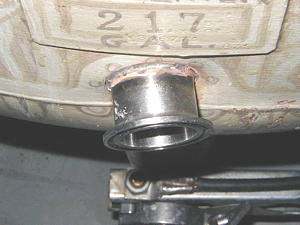
BEFORE photo
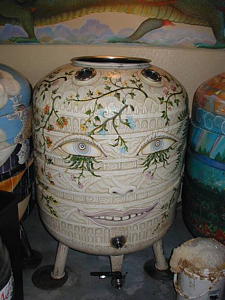
A particularly nice tank


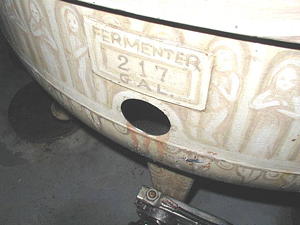
Holesaw cut
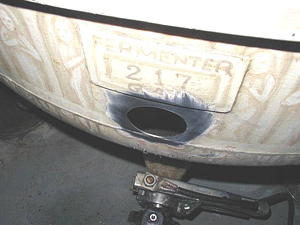
Cleaned
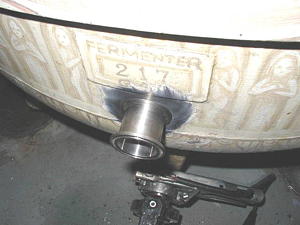
New spout tacked on
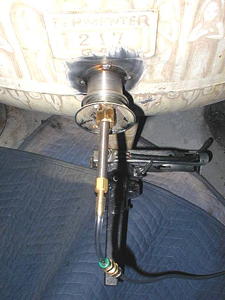
Purge
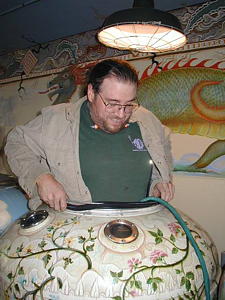
Snug
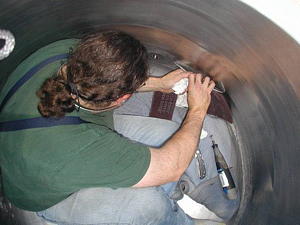
Interior cleanup
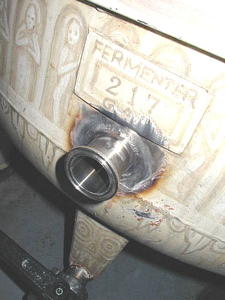
Welded exterior
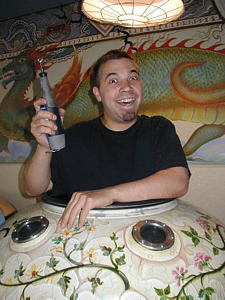
Demented assistant

Keg rinsing station

Keg rinsing station

Keg rinsing station